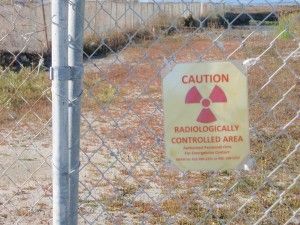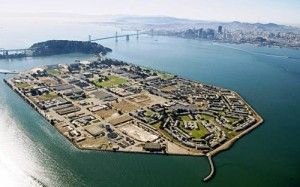Treasure Isle: Greed, Gold, Toxic Waste
by Richard Trainor | July 26, 2011 8:57 am
 [1]
[1]
Yo ho ho and and a pot of redevelopment gold.
For 15 years San Francisco has tried to transform Treasure Island from a sandy former Naval base into a gold and jobs-generating new urban community with 40-story skyscrapers interspersed by parks and marinas. The idea came from then-Mayor Willie Brown as far back as 1995.
On June 15, 2011, San Francisco Mayor Ed Lee finally signed the formal approval to allow the redevelopment of Treasure Island to begin. While the city has been remarkably patient in its mission to secure approval for the $1.5 billion project, this project represents a golden opportunity to build a new city center for 19,000 new tax-paying residents.
There will be huge new skyscrapers secured into the volatile landfill with earthquake-proof foundations, a number of community parks, a seawall to prevent tsunamis and tons of sand imported to stabilize the land-filled island. Before the Loma Prieta earthquake in 1989, Treasure Island stood 18 feet above sea level. After the quake, it was at 6 feet. The new sand will be compacted into the existing soil to provide a solid base for the coming towers.
Mark Sarkisian of Skidmore, Owings & Merrill, the firm’s chief structural engineer on the project, said the towers and the other new buildings will be safe. He said, “We did shaker-table modeling and computer-generated effects to see how the new buildings will perform and we’re satisfied they will be able to safely withstand a 7.5 earthquake.”
Critics like Aaron Peskin, the former president of the San Francisco Board of Supervisors, don’t think the seismic or traffic issues have been thoroughly explored or tested. “I’d say that if you believe that the seismic issues are resolved, then you’re either a total optimist or an absolute fool,” said Peskin, who is presently weighing the idea of pursuing a legal action against the Treasure Island Development Authority (TIDA). “If we do bring an action, it will likely relate to the EIR [Environmental Impact Report] for the project.”
Indeed, as Anthony Pignataro reported on this site last year[2], Treasure Island has a toxic problem. He wrote that “a disputed portion of Treasure Island — the Navy says just a few sites, others say possibly the entire island — is radioactive. What to do about the radiological contamination has become the great unmentionable in the quest to turn the old, rapidly decaying base into San Francisco’s ‘premier date-night locale’….”
 [3]Opponents Outgunned
[3]Opponents Outgunned
At this point, Peskin and Treasure Island development opponents appear to be outgunned. TIDA’s attorney-of-record on this is Tina Thomas, of the Sacramento law firm Ramey-Thomas. When she served in the first Jerry Brown gubernatorial administration, Thomas wrote the California Environmental Quality Act (CEQA) in 1974. Now she tends to serve developer interests, such as Sacramento’s Angelo Tsakopolous and Ron Burkle, the billionaire who is involved in the Treasure Island redevelopment plan.
The TIDA project involves Florida-based Lennar Properties, Wilson Meany Sullivan and Kenwood Investments (the Burkle-Anderson group) who say they hope to break ground early next year. The city of San Francisco is also a partner on the deal, since it’s chipping in $700 million in bonds; while Kenwood et al. are in for $500 million. The developers are projecting $370 million in profit at build out, and the city gets a taste of it.
Over the next few decades, Lennar and friends will transform the island into a state-of-the-art neighborhood with a mix of affordable and market-rate energy efficient homes. Massive weight will compact the soil, keeping the island stable during earthquakes. A 30-foot seawall will guard against sea-level rise and possible tsunamis. Plans call for the ramps to and from the Bay Bridge to be redesigned and dedicated bus lines to run from the island to downtown San Francisco.
High-Paying Jobs
There are numerous reasons to welcome the new development at Treasure Island from a policy standpoint. It will create high-paying construction and engineering jobs for the length of the 20-30 year build out. It will also increase tax revenue and provide new housing for maxed-out San Francisco.
There are other reasons to abhor Treasure Island from a political process standpoint, for the redevelopment of this naval base is easily one of the sleaziest deals ever put forward in a city where political sleaze has reigned supreme since the octopus [4]of Southern Pacific Railroad[5] extended its tentacles over the city at the end of the 19th century.
Grand jury investigations into Treasure Island have occurred. The governing agency for the project, TIDA, is a bit of a mystery as to what kind of agency or corporation or city entity it is exactly, and recent rulings have relaxed the ethical questions that have characterized the process since it started.
Willie’s Plans
In 1998, reporter Chuck Finnie of The San Francisco Examiner wrote a story, “Mayor’s Pals find Treasure on Island[6],” in which he laid out the plans that Mayor Willie Brown then had for Treasure Island.
Finnie reported:
“Political patrons of Mayor Brown who are favored for a Treasure Island redevelopment deal would pay The City at least $1 million less than the other two bidders, a Port of San Francisco financial report says…. The project is one of several in which the mayor’s staff and city commissioners have been asked to make business decisions involving people close to Brown…. Anderson worked as a volunteer raising money for Brown’s $2 million mayoral campaign.
“Burkle, who is backing Anderson’s bid financially, is a Los Angeles investor and former law client of the mayor’s during Brown’s days as speaker of the Assembly.
“The report, obtained by The Examiner under state public records law, raises questions about why the mayor is recommending the deal go to Treasure Island Enterprises, the creation of Anderson and Burkle…. [A] mayor’s selection committee judged Anderson and Burkle’s proposal best.”
One of Lennar’s partners in the Treasure Island deal, Kenwood Investments, is the outgrowth of the original company hand-picked for Treasure Island by Willie Brown in 1998. Kenwood is headed by Burkle and Anderson.
Theme Park Plan
Willie Brown’s Treasure Island plan was first put forward in a document, “The Treasure Island Reuse Plan.” This plan would have transformed the former U. S. Naval base into a tourist-oriented theme park. The lead agency for the conversion would have been the San Francisco Redevelopment Agency.
In 1995, Willie advanced the idea that it would make a suitable location for Indian gaming casinos. In 1998, Willie tried to enlist reclusive Hong Kong billionaire Li Ka-Shing to develop it as such. But Li wouldn’t bite. “It was sort of a unique time,” said Larry Florin, who oversaw Treasure Island for the city in the late 1990s. “Land-use planning in San Francisco is like hand-to-hand combat, and you had this detached piece of property that no one thought about, so it was an opportunity for some free thinking to occur.”
Sweetheart Deal
Free thinking is one way to describe it. Treasure Island has been a sweetheart deal ever since the process got underway in the late 1990s. After Brown failed to get the project moving, the next mayor, Mayor Gavin Newsom, took a bite at the Treasure Island apple during his term. Newsom was figuratively caught with his pants down at a fund-raiser for him hosted by Burkle’s partner Darius Anderson in Sacramento in 2004. Again, the plan didn’t fly.
Present Mayor Ed Lee finally succeeded where the previous two had failed — despite a narrow, 4-3 approval by the San Francisco Planning Commission before the Board of Supervisors passed the plan unanimously by an 11-0 vote.
The Treasure Island project envisions a new ecologically friendly, “smart growth”-oriented, “sustainable” mini-city of 19,000 residents. It would have set-aside proportions of 20 percent of the new housing units designated for “low-income families” and the homeless with shining new high-rise commercial and residential towers interspersed among “pedestrian-oriented” retail units. All of it will be served by new ramped-up ferry services from San Francisco and the East Bay to Treasure Island to insure the “sustainability” quotient.
Most of the main players in the San Francisco Democratic Party Insider Club are also on board the Treasure Island Express. Besides Willie Brown, Gavin Newsom, Darius Anderson and Ron Burkle, the Treasure Island gold miners include Rep. Nancy Pelosi, D-San Francisco, and some of her family.
“There is no question there is a concerted effort to make this a political issue by some,” said Nancy Pelosi, speaking on the issue in 2010 when a new mosque was being proposed for Ground Zero in New York. “And I join those who have called for looking into how is this opposition to the mosque being funded. How is this being ginned up that here we are talking about Treasure Island, something we’ve been working on for decades, something of great interest to our community as we go forward.”
Indian Casinos
Pelosi, then-Mayor Gavin Newsom and Navy Secretary Ray Mabus signed the transfer agreement on Tuesday, June 10, 2010. It included a section of neighboring Yerba Buena Island, where Native American Indian remains were found in 2003. That makes Yerba Buena Island a potential site for Indian gaming casinos.
Pelosi has used her power to push the crony-infested project for years. She pushed hard for legislative language that would have forced the military to grant highly valued properties at no cost to the local communities.
“Treasure Island is not a case of a small town that has relied on a local military base for its livelihood for decades. It is a land grab by politicians for well-connected developers,“ said Tony Hall[7], the former executive director of the Treasure Island Development Authority and a mayoral candidate. The authority is the firm that grew into an entity that Aaron Peskin said is “one of the great mysteries of our time. It’s a non-profit that grew into a LLC that then became a city agency.” Hall called the city’s effort to develop the island a “den of corruption.”
Peskin quoted a news story back to me: “A proposed Treasure Island development plan slates 90 percent of the developed acreage for residential use, 7 percent for commercial property and 3 percent for parking. An illustration shows about a dozen high-rise blocks of shoreline condominiums with stunning views of the city, plus 300 acres of park and recreation land.”
“This would hardly be ‘affordable housing,’ the $5 billion investment that Mrs. Pelosi claims would have to be recouped by the developer, Peskin snorted. “The only long-term jobs created from this plan would be for maids and doormen for the high rollers privileged enough to live there.”
The likelihood of a successful legal challenge to TIDA isn’t good. There are powerful political and economic forces at work here, and the whole Democratic Party team out of San Francisco is backing the plan. Willie Brown’s dream of gold on Treasure Island seems to be coming true.
- [Image]: http://www.calwatchdog.com/wp-content/uploads/2011/07/Treasure-Island-toxic.jpg
- reported on this site last year: http://www.calwatchdog.com/2010/10/11/treasure-islands-toxic-problem/
- [Image]: http://www.calwatchdog.com/wp-content/uploads/2011/07/Treasure-Island.jpg
- octopus : http://en.wikipedia.org/wiki/The_Octopus:_A_Story_of_California
- Southern Pacific Railroad: http://en.wikipedia.org/wiki/Southern_Pacific_Railroad
- Mayor’s Pals find Treasure on Island: http://www.sfgate.com/cgi-bin/article.cgi?f=/e/a/1998/11/16/NEWS7916.dtl
- Tony Hall: http://en.wikipedia.org/wiki/Tony_Hall_(supervisor)
Source URL: https://calwatchdog.com/2011/07/26/s-f-s-treasure-island-greed-gold-toxic-waste/